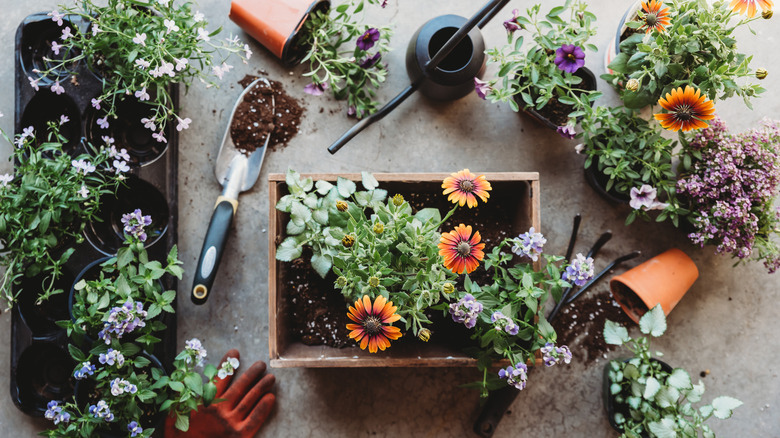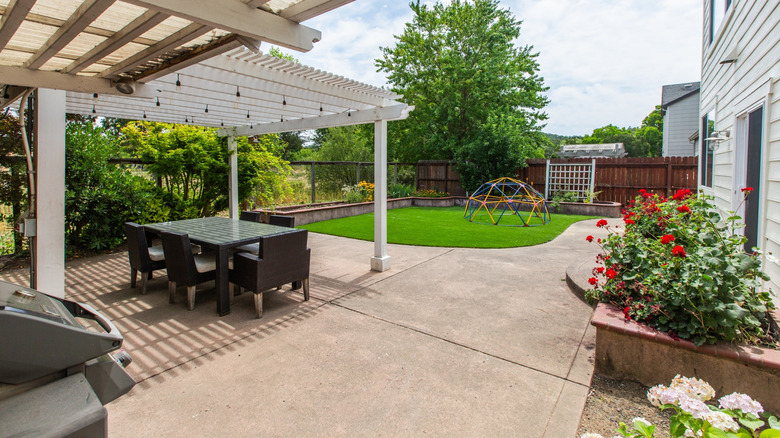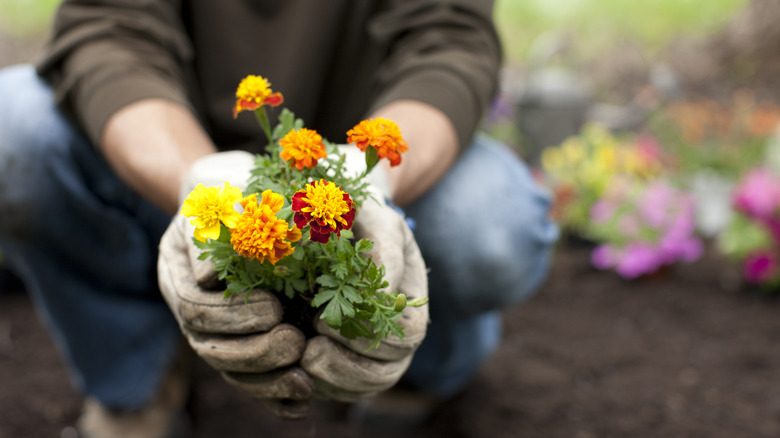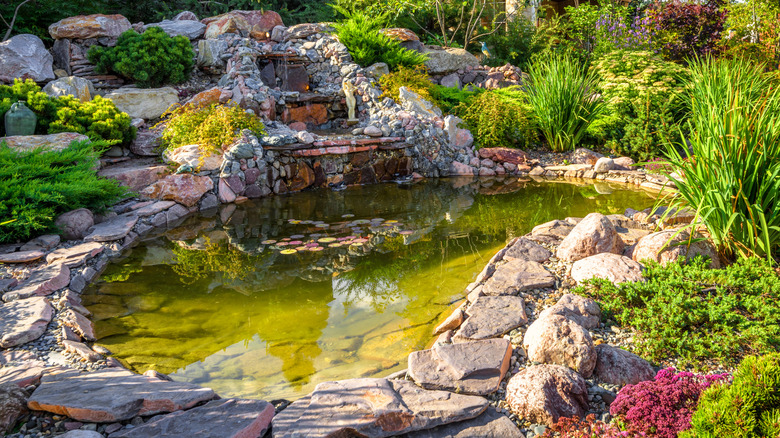Outdated Gardening Trends To Say Goodbye To In 2025
We may receive a commission on purchases made from links.
Just like fashion trends, garden and landscape designs also change with the times. Not as quickly as fashion, to be sure ("Those marigolds are SO last year!"). Over time, however, certain trends catch on as others fade out. If you're looking to have the hippest garden on the block, then it's time to embrace the new and leave some old, dated ideas behind. If you're old enough to remember mirrored gazing balls and other gaudy "yard art," you know that change can be for the better. And the really good news is, your yard may be all the healthier for it!
The TL;DR is that overly manicured spaces are passé in favor of more natural, eco-friendly options. No longer do we gravitate toward formal designs and non-native plants when we can instead embrace native species in more natural, less-structured spaces. Sprinkle in a little high-tech gadgetry, and now we're in 2025! Embracing the new while honoring the wild is the wave of the future. This type of "eco-optimism" in gardening is partly a reflection of the sobering climate times we live in mixed with trending ideas we find all around us. And, just like fashion, garden trends are highly subjective, so see which of these land for you and which ones might need to take a hike, like "mom jeans." Or are those still in?
Hardscapes are out, softer looks are in
Instead of the streamlined look of hard paved surfaces such as concrete patios, landscaping blocks, retaining walls, walkways, and brick work, the trend is to move toward softer, more porous surfaces. Impervious surfaces are being replaced with more water-friendly options such as gravel or plants and other horticultural elements that can absorb water and reduce runoff. Runoff from urban spaces causes pollutants like fertilizer and pesticides to find their way into storm drains and subsequently rivers and streams. The EPA says it's one of the country's biggest threats to clean water. If we can keep rain in our yards, it not only benefits the plants, but reduces flooding and safeguards the water supply.
If you still like a paved look in your yard or garden, paver blocks, and other hardscape elements are now being made in water-permeable options like these interlocking tiles from Gardenised that look like garden stones but allow for water drainage. Some of these products are made out of recycled materials also, which is an added bonus.
In addition to retaining valuable moisture, reducing hardscapes in the garden offers a softer, more natural look to the landscape instead of a more uniform, sterile appearance. This is much of the draw of the "cottagecore" garden movement, incorporating more fairy-like aspects such as natural stone walls, meandering cobblestone pathways, small ponds, trellises of lush climbers, or any other Hobbit-esque bits that evoke the idyll and romance of the English countryside.
Say no mow to large, manicured lawns
Just like hardscapes are biting the dust, so is the large, classic manicured lawn — perfect lawn mower lines and all. Many homeowners are trending toward less grass in favor of more wild garden space. Some are even swearing off traditional grasses altogether and replacing them with wildflower lawns or grass alternatives like clover. Not only is there little to nothing to mow, but they're drought friendly and can attract pollinators and beneficial insects. This more natural look is also more inviting to wildlife, especially when combined with native plants that they like to munch on.
Having a smaller or non-traditional lawn also means cutting back on toxins and pollutants like fertilizers, weed killers, and pesticides that were keeping that lawn looking perfect. It also means reducing your water consumption for irrigation. And, of course, less mowing and upkeep means more free time for you. That's a lot of wins in just one small change to your landscaping.
Once the grass is out, it's up to you how you want to fill the space. We recommend drought-resistant, native plants for landscaping rather than exotic ornamentals. By choosing native, you won't have to skimp on color or variety, and they will support your local ecosystem of birds and bugs that keep the environment healthy.
Goodbye annuals, hello perennials
In addition to choosing native plants for your gardens, it's also a growing trend to choose perennial plants over those that bloom once and then disappear forever. Instead of reinventing the wheel every year, why not plant items with a lot of variety in color, height, and texture and enjoy watching their full life cycle? It's especially rewarding if you use plants and flowers that bloom at different times during the growing season so that there's always something cheerfully blooming.
Aside from the added maintenance and expense of growing annuals, they tend to have shallow root systems and can dry out quickly if you miss a watering cycle or have an extended heat wave. They also often have shorter bloom times than perennial plants, meaning those stunning blossoms won't be around for long. If you choose to go the perennial route, you'll have to put up an initial outlay to purchase the plants and wait a growing season or two for them to become well established. You'll also need to give them a little TLC along the way such as cutting, pruning, and possibly fertilizing them to ensure that they stay healthy. But once they mature, you'll be able to enjoy them for seasons to come.
This isn't to say that you shouldn't sprinkle a few annuals in here and there as your time, budget, and interest allow. Whether they're in pots or planted directly into the ground, those little pops of color may hold sentimental value for you. Some people can't picture a summer without petunias or gerbera daisies.
Move over fancy water features, now there's something simpler
The backyard fountains and ponds of yesteryear are being replaced by more simplistic and natural-looking options like rain gardens that naturally direct rainwater runoff to plants. Homeowners have realized that the big, dramatic water features of the past were too expensive to install and too hard to maintain to keep operational. They often required pumps, filters, and tubing, along with regular cleaning — and they also used a water connection to operate, which is controversial in these days of water conservation. Contrast that with a more organic aesthetic such as a natural pond, stream, or a rain garden, and you can see why the natural approach is winning out.
Rain gardens are simply an area dedicated to native grasses and flowers that can absorb runoff while also providing habitat for local birds, insects, and other wildlife. This type of landscaping is called bioretention and is considered a water-smart design. If you live in an area that doesn't receive a lot of rain, you can opt for different natural features in your yard such as a cactus or succulent garden. Find out what native plants do well in your location and give those a try.
The era of dumb gardening is over
Are you gardening without technological assistance? You don't have to — you can garden more efficiently in this age of apps and high tech gadgetry. "Smart gardening" means embracing the devices, gizmos, and apps that have recently been invented to make our lives as gardeners easier. It's similar to the "smart home" movement where you don't even have to get up to turn lights on and off. In the gardening world, this looks like "smart sprinklers" that set scheduled waterings through a phone app and are tied into your local weather. You can also try using Jiyang solar automatic drip irrigation to make sure all your plants are getting exactly what they need.
There are "smart greenhouses" with sensors to control every aspect of growing like humidity and temperature. You'll even get alerted when it's time to add fertilizer. As you can imagine, there are many gardening apps available to help you plan your crops and planting times. There are also AI gardening assistants to offer advice and help you set up schedules for plant care. You can use various online garden planning tools to lay out your garden plot well before the first seed is planted. With a smartphone in your pocket, there is no limit to the help and automation you can use as a state-of-the-art gardener in the technical age.





